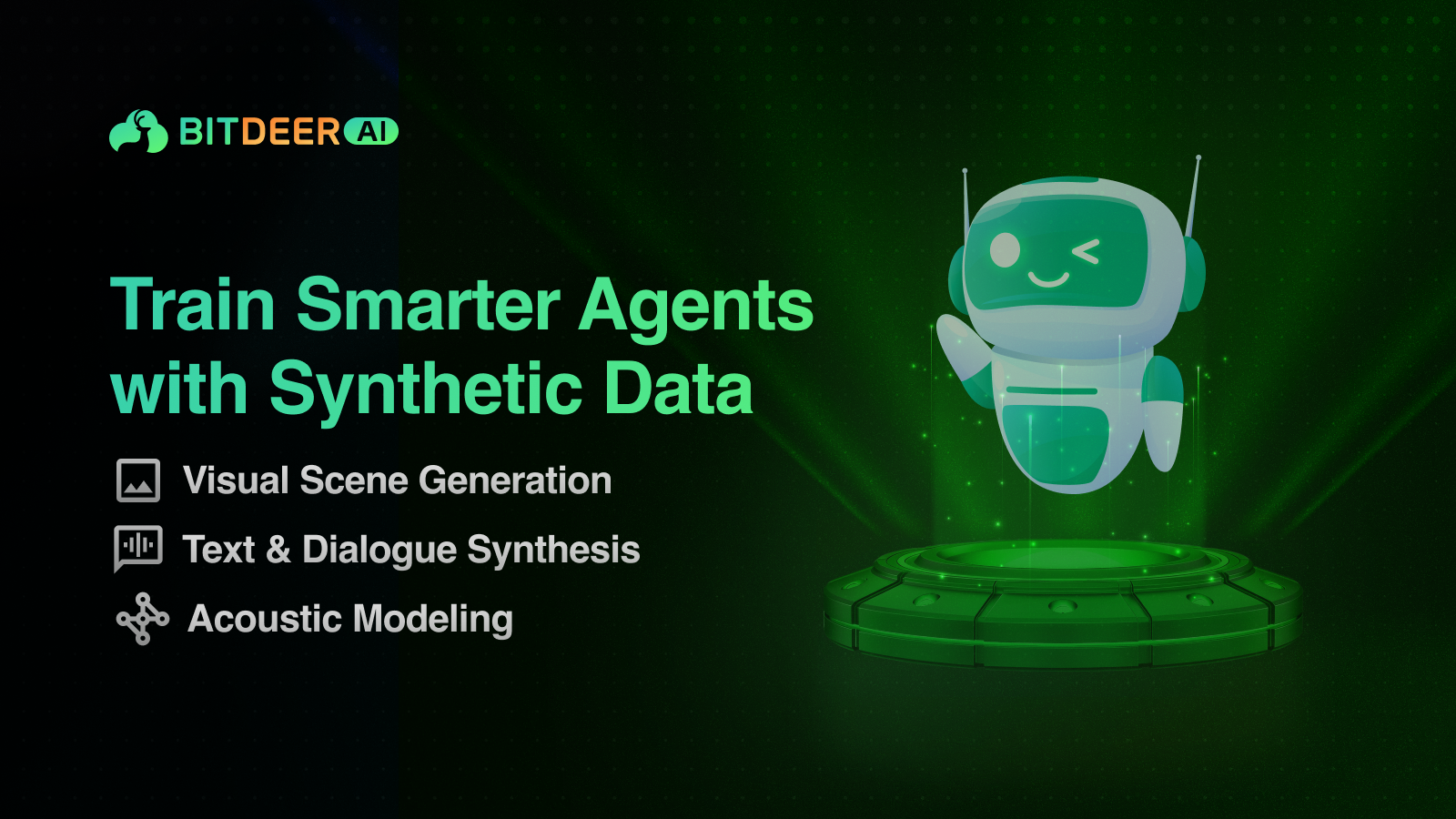Synthetic Data for Multimodal Agent Training

In a rapidly evolving AI landscape, businesses are under growing pressure to deploy agents that can understand and respond across text, vision, and audio channels. Yet collecting, annotating, and curating real-world multimodal datasets is often costly, labor-intensive, with compliance hurdles. Synthetic data offers a compelling alternative, enabling businesses to accelerate development cycles, reduce compliance risk and tailor training sets to their unique use cases.
A robust synthetic-data pipeline typically consists of three core stages:
- Visual Scene Generation
- Procedural Environments: Use engines like Unreal or open-source Blender to create varied settings like offices, factories, retail spaces.
- Dynamic Variation: Randomize lighting, object arrangement, and camera parameters to cover corner-case scenarios (e.g., low-light warehouses, crowded convention halls).
- Text & Dialogue Synthesis
- Prompt-Driven Captions: Leverage pretrained language models to describe scenes (“A mahogany desk with two laptops facing each other”).
- Instruction Generation: Automatically craft agent prompts (“Please scan the QR code on the leftmost brochure stand”) with few-shot examples to ensure domain-specific terminology are adhered to.
- Acoustic Modeling
- Room Impulse Responses (RIRs): Simulate reverberation and background noise profiles for environments such as boardrooms or noisy factory floors.
- Text-to-Speech (TTS): Produce diverse synthetic voices such as customizing accent, tone, and pace, to train agents on robust speech recognition.
Quality assurance in this context requires both automated analysis and human-in-the-loop validation. On the automated side, teams compare embedding distributions by using Contrastive Language-Image Pre-training (CLIP) or ResNet features, between synthetic and real samples to detect anomalies. Proxy evaluations (e.g., running pretrained object detectors or ASR models on synthetic data) further reveal fidelity gaps. Concurrently, targeted crowdsourced reviews rate scene realism and annotation accuracy, with rating scores fed back into generation parameters to fine-tune variables such as lighting range, vocabulary complexity, and noise levels.
When it comes to training strategies, mixing synthetic and real data yields the best results:
- Two-Phase Curriculum:
- Pretrain on large synthetic volumes to build foundational multimodal representations.
- Fine-tune on a curated real dataset to ground models in authentic nuances.
- Interleaved Curriculum:
- Mix synthetic and real samples within each training epoch, gradually shifting the ratio from predominantly synthetic data to predominantly real data.
- Adjust mix dynamically (e.g., start at 80% synthetic and taper to 20% over time).
- Domain Adaptation:
- Employ adversarial fine-tuning or style-transfer techniques (such as CycleGAN) to minimize visual and acoustic sim-to-real discrepancies.
Case Study: Indoor Visual Question Answering (VQA)
- Objective: Train an agent to answer questions about objects and spatial relations in home environments.
- Synthetic Pipeline:
- Scene Creation: Procedurally generate hundreds of unique living‐room layouts with variation in furniture, lighting, and camera angles.
- Caption & Question Generation: Use prompts to produce paired captions (“A blue vase sits on the coffee table.”) and question–answer pairs (“Where is the vase located?” → “On the coffee table.”).
- Quality Checks: Run a pretrained VQA model on synthetic images; flag samples where the model’s answer confidence is low for human review.
- Results: Compared to training on 10 K real images alone, a model pre-trained on 100K synthetic scenes achieved a 15 % relative gain in accuracy after fine-tuning on the same real set.
Despite these gains, synthetic data pipelines demand careful balancing. High-resolution rendering and physics-based modeling incur substantial compute costs, requiring teams to decide where to prioritize detail versus throughput. Ensuring diversity across cultural contexts, architectural styles, and linguistic variations is also critical to prevent inadvertent bias. Emerging tools like neural rendering and collaborative platforms (e.g., NVIDIA Omniverse) are streamlining these workflows, but continuous monitoring and iterative refinement remain paramount.
Looking ahead, emerging tools promise to further streamline synthetic workflows. Neural rendering techniques, for example, can generate photorealistic visuals with lower computational overhead, while integrated platforms like NVIDIA Omniverse facilitate collaborative dataset creation at enterprise scale. As these capabilities mature, synthetic data will transition from a niche experiment to a strategic necessity, empowering businesses to train the next generation of multimodal agents faster, more affordably and with greater confidence.
By embracing synthetic data pipelines today, organizations can position themselves to lead in every sector where AI agents are poised to transform customer engagement, operational efficiency and product innovation. As the technology continues to evolve, those who invest early in robust, multimodal synthetic workflows will reap outsized returns in both performance and time-to-market.